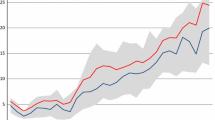Abstract
It is often argued that the persistent amounts of excess reserves in the 1934–1941 period were sought either for protective liquidity or as a signal of bank safety to depositors. More recent explanations argue that these excess reserves were unintended inventory due to the high internal adjustment costs of converting reserves to income-producing assets. Our findings support the latter explanation and reveal high internal asset adjustment costs after 1933. Thus, a monetary policy focused on increasing reserves would have been ineffective. A successful monetary policy would be one that increased outside money.(JEL G210, G280, O420)
Similar content being viewed by others
References
Bernanke, Ben S. 1983. “Nonmonetary Effects of the Financial Crisis in the Propagation of the Great Depression.”American Economic Review 73: 257–76.
Bernanke, Ben S. 1995. “The Macroeconomics of the Great Depression: A Comparative Approach.”Journal of Money, Credit and Banking 27: 1–28.
Bernanke, Ben S., and Mark Gertler. 1990. “Financial Fragility and Economic Performance.”Quarterly Journal of Economics 105: 87–114.
Board of Governors of the Federal Reserve. 1943.Banking and Monetary Statistics. Washington, D.C.
Breusch, T. S., and A. R. Pagan. 1980. “The Lagrange Multiplier Test and its Application to Model Specification in Econometrics.”Review of Economic Studies 47: 239–253.
Calomiris, Charles W., and Berry Wilson. 1996. “Bank Capital and Portfolio Management: The 1930s Capital Crunch and Scramble to Shed Risk.” InRethinking Bank Regulation: What Should Regulators Do? Thirty Second Annual Conference on Bank Structure and Competition (Federal Reserve Bank of Chicago): 515–530.
Cuthbertson, Keith. 1988. “The Demand for M1: A Forward Looking Buffer Stock Model.”Oxford Economic Papers 40: 110–131.
Cuthbertson, Keith, and Mark P. Taylor. 1987. “The Demand for Money: A Dynamic Rational Expectations Model.”Economic Journal 97 Supplement: 65–76.
Cuthbertson, Keith, and Mark P. Taylor. 1989. “Anticipated and Unanticipated Variables in the Demand For M1 in the UK.”Manchester School of Economics and Social Studies 57: 319–39.
Davidson, James E., David F. Hendry, Frank Srba, and Stephen Yeo. 1978. “Econometric Modelling of the Aggregate Time-Series Relationship Between Consumers’ Expenditure and Income in the United Kingdom.”Economic Journal 88: 661–692.
Dickey, David A., and Wayne A. Fuller. 1981. “Likelihood Ratio Statistics for Autoregressive Time-Series With a Unit Root.”Econometrica 49: 1057–1072.
Engle, Robert F. 1982. “Autoregressive Conditional Heteroskedasticity with Estimates of the Variance of United Kingdom Inflation.”Econometrica 50: 987–1007.
Ferderer, J. Peter, and David A. Zalewski. 1994. “Uncertainty as a Propagating Force in the Great Depression.”Journal of Economic History 54: 825–49.
Friedman, Milton, and Anna J. Schwartz. 1963.A Monetary History of the United States 1867–1960. Princeton, NJ: Princeton University Press.
Frost, Peter A.. 1971. “Banks’ Demand For Excess Reserves.”Journal of Political Economy 79: 805–825.
Godfrey, Leslie G.. 1978. “Testing Against General Autoregressive and Moving Average Error Models When the Regressors Include Lagged Dependent Variables.”Econometrica 46: 1293–1301.
Hall, Stephen G. S., G. B. Henry, and Simon Wren-Lewis. 1986. “Manufacturing Stocks and Forward Looking Expectations in the UK.”Economica 53: 447–465.
Hansen, Lars Peter, and Thomas J. Sargent. 1981. “Linear Rational Expectations Models for Dynamically Interrelated Variables.” InRational Expectations and Econometric Practice, edited by Robert J. Lucas and Thomas J. Sargent. Minneapolis: University of Minnesota Press.
Mason, J., Ali Anari, and James Kolari. 2000. “The Speed of Bank Liquidation and the Propagation of the Great Depression.” InThe Changing Financial Industry and Regulation: Bridging States, Countries and Industries, Thirty Sixth Annual Conference on Bank Structure and Competition (Federal Reserve Bank of Chicago).
Mounts, W. Stewart, Clifford B. Sowell, and Atul K. Saxena. 2000. “An Examination of Country Member Bank Cash Balances of the 1930s: A Test of Alternative Explanations.”Southern Economics Journal 66: 923–941.
Morrison, George R. 1966.Liquidity Preferences of Commercial Banks. Chicago, IL: University of Chicago Press.
Ramos, Alberto M. 1996. “Bank Capital Structures and the Demand for Liquid Assets.” InRethinking Bank Regulation: What Should Regulators Do? Thirty Second Annual Conference on Bank Structure and Competition (Federal Reserve Bank of Chicago): 473–501.
Romer, Christina D. 1992. “What Ended the Great Depression.”Journal of Economic History 52, 757–784.
Sargent, Thomas J. 1987.Macroeconomic Theory. 2nd ed. Orlando, FL: Academic Press.
Sealey, C. W., Jr., and James T. Lindley. 1977. “Inputs, Outputs, and a Theory of Production and Cost at Depository Financial Institutions.”Journal of Finance 32: 1251–1266.
Warburton, Clark. 1950. “The Theory of Turning Points in Business Fluctuations.”Quarterly Journal of Economics 64: 525–549.
White, Halbert. 1980. “A Heteroskedasticity-Consistent Covariance Matrix Estimator and a Direct Test for Heteroskedasticity.”Econometrica 48: 817–838.
Author information
Authors and Affiliations
Additional information
Partial funding for this paper was provided by the Kentucky EPSCoR Program. We thank Patrick Marchand, David Schutte, Fallaw Sowell, Randall Parker, and Richard Timberlake for helpful comments on this paper.
Rights and permissions
About this article
Cite this article
Lindley, J.T., Sowell, C.B. & Mounts, W.S. Excess reserves during the 1930s: Empirical estimates of the costs of converting unintended cash inventory into income-producing assets. J Econ Finan 25, 135–148 (2001). https://doi.org/10.1007/BF02744518
Issue Date:
DOI: https://doi.org/10.1007/BF02744518




